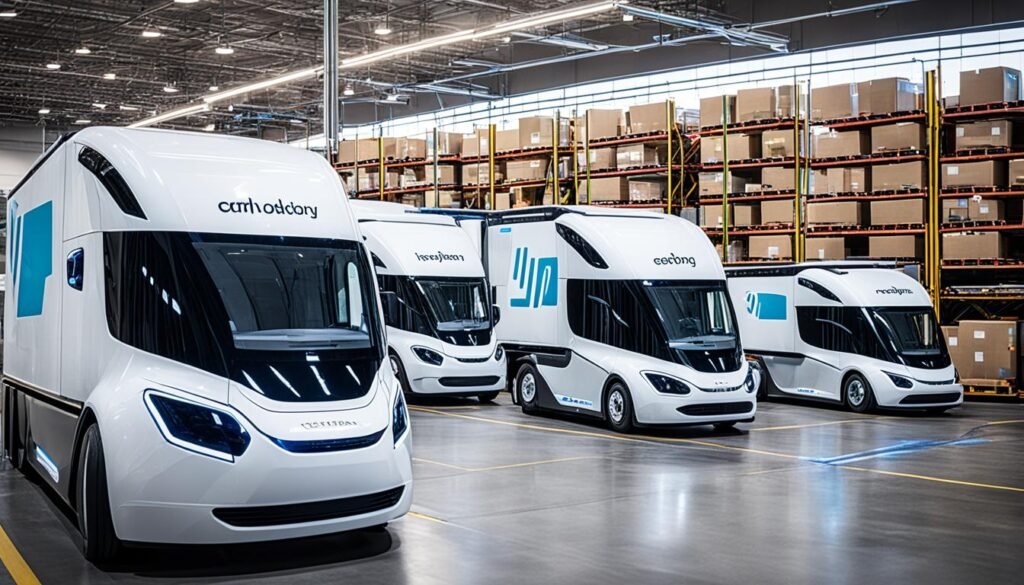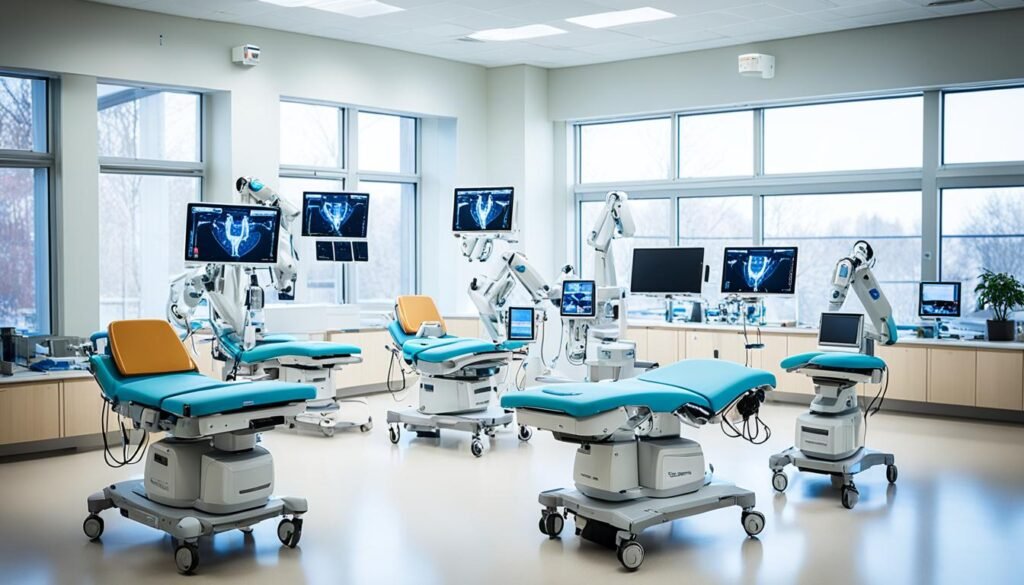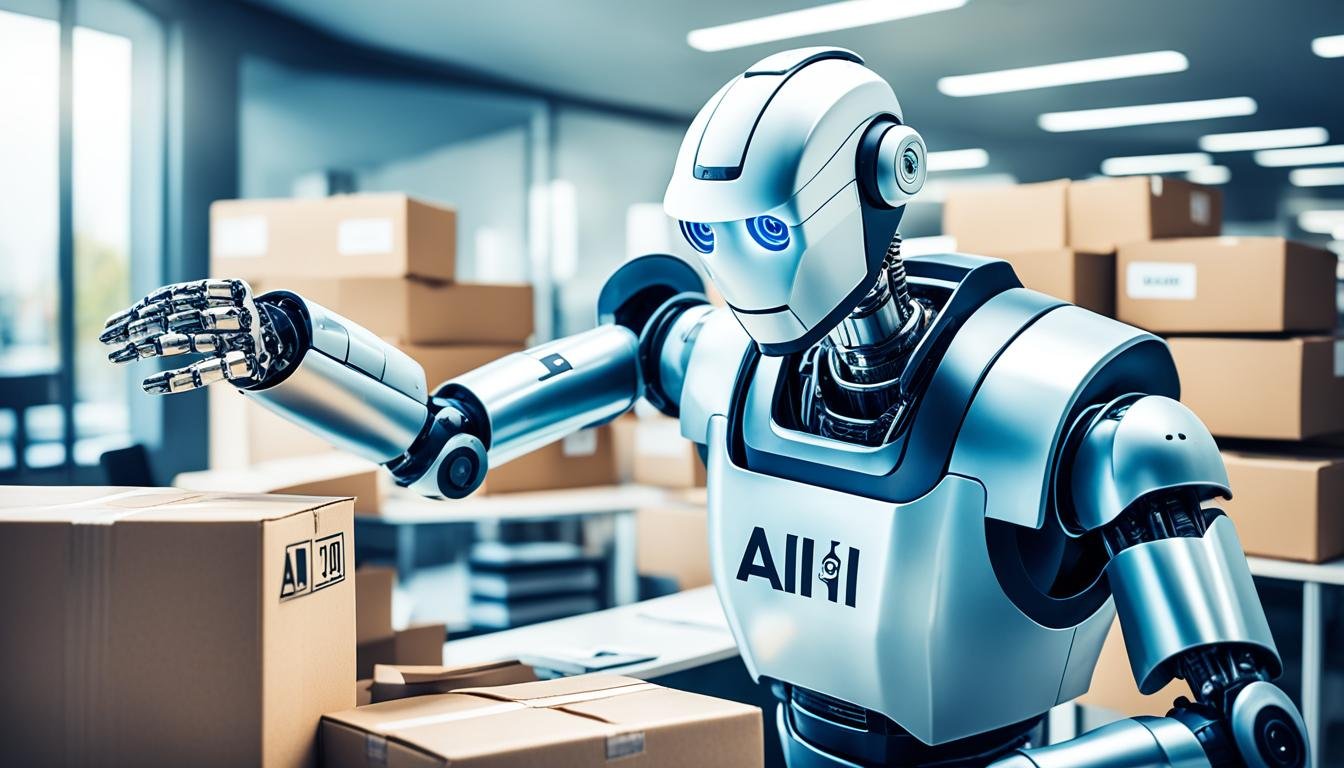A recent study by Goldman Sachs found that AI could take away 300 million jobs in the U.S. and Europe by 2030. This shows how fast automation is moving and its big effect on the workforce in the next ten years.
AI and robotics are getting better, threatening many jobs. From data entry and customer service to healthcare and manufacturing, many jobs could change. This change could increase global GDP by up to 7% but also brings big challenges for workers and leaders.
This article will look at which jobs and industries are most at risk from AI. We’ll also talk about the economic effects and how to deal with this big change in the future of work.
Key Takeaways
- AI and automation could replace up to 300 million jobs in the U.S. and Europe by 2030.
- Low-skill, repetitive jobs are at the highest risk of automation, including data entry, telemarketing, and assembly line work.
- Even some technical jobs in the healthcare sector may be impacted by AI-powered automation.
- Jobs requiring human skills like emotional intelligence, creativity, and complex problem-solving are less likely to be automated.
- The impact of AI on employment could be significant, with an expected 400 to 800 million people globally losing their jobs due to AI by 2030.
The Rise of AI and Automation
AI and automation are changing the job market fast. A McKinsey report says AI will replace 2.4 million US jobs by 2030. It also predicts 12 million jobs will change in some way. Worldwide, 400 to 800 million people might lose their jobs due to AI.
Recent Studies on Job Automation
A study by the McKinsey Global Institute found AI could add $13 trillion to the global economy by 2030. This would be like the impact of big changes in the past. But, AI and automation also bring big challenges for work in the future.
McKinsey‘s labor report says up to 30% of US work hours could be automated by 2030. This means many jobs could be replaced by AI and robots.
AI’s Potential Economic Impact
The McKinsey Global Institute thinks AI could replace 300 million full-time jobs globally. A report by a university and OpenAI says workers making up to $80,000 a year could be most at risk.
AI’s benefits are big, but it will also shake up the job market a lot. Experts say nearly 50% of jobs in transportation and over 5% of warehouse jobs could be taken over by AI by 2030. This could mean over 10 million jobs lost in the US in the next 5 to 10 years.
“AI is projected to replace 2.4 million US jobs by 2030, with an additional 12 million occupational shifts.”
AI and automation will do more than just cause job losses. They will change what jobs are available. The McKinsey Global Institute says nearly 12 million US workers may need to switch jobs by 2030. We’ll need to work hard to retrain and reskill workers for the new job market.
Jobs at High Risk of Automation
AI and automation are changing the job market fast. Some jobs are at high risk of being replaced by new technologies. Studies show that nearly 50% of jobs in transportation and over 5% of warehouse jobs could be taken over by AI and robotics by 2030. This means over 10 million jobs in the U.S. could be at risk of automation in the next 5 to 10 years.
Transportation and Warehousing Jobs
Drivers, whether they work in taxis, trucks, or delivery vans, are at risk as self-driving technology gets better. Warehouse workers are also at risk, with automated machines already working alongside them in some places. The growth of self-driving vehicles and automated logistics systems will greatly affect the transportation and warehousing sectors. This could lead to many job losses in these areas.
Retraining for the Automated Future
To get ready for an automated future, workers in these fields need to retrain and learn new skills. It’s important to invest in education and training programs. This will help workers stay competitive and adapt as AI and automation change the job market.
| Occupation | Automation Risk by 2030 |
|---|---|
| Truck Drivers | 79% |
| Taxi and Rideshare Drivers | 67% |
| Warehouse Workers | 64% |
| Delivery Drivers | 59% |
The table shows how big the risk is for jobs in transportation and warehousing because of self-driving vehicles and automated logistics. As these technologies get better, the need for human workers will go down. It’s important for workers to get ready for the automated future by retraining and developing new skills.

“By 2030, around 12 million Americans in occupations with shrinking demand may need to switch jobs due to AI, with an estimated 30% of work hours in the US being automatable by that time according to a McKinsey analysis.”
Food Service and Retail Roles
AI and automation are changing the food service and retail sectors a lot. A study by the McKinsey Global Institute says nearly 12 million Americans might need new jobs by 2030. This change will hit the food service and retail industries hard.
Automated Kitchens and Self-Service Kiosks
Food service automation is changing how we make and serve food. In fast-food places, automated kitchens are now making burgers and tacos. These machines could replace up to 86% of cooks and food workers.
Self-service kiosks are also becoming more common in stores. They make checking out easier for customers, which means fewer jobs for cashiers and sales staff. The study says over 800,000 retail jobs could be lost in the next ten years.
The Impact of E-Commerce on Retail Jobs
More people shopping online is affecting traditional retail jobs a lot. As online shopping grows, stores need fewer salespeople and cashiers. The McKinsey study predicts over 800,000 retail jobs could be lost by 2030 because of this.
These changes are big for the food service and retail industries. Workers need to learn new skills to keep up. As AI and automation change these fields, it’s important for workers to be ready for the future.
| Industry | Job Roles at Risk | Estimated Job Losses by 2030 |
|---|---|---|
| Food Service | Cooks, Food Prep Workers | Up to 86% of jobs automated |
| Retail | Retail Salespeople, Cashiers | Over 800,000 jobs lost |
“By 2030, nearly 12 million people may have to change jobs because of advances in automation and AI, particularly those in lower-paying positions with repetitive tasks.”
Office and Administrative Support
Technology is changing the way we work, making office and administrative support roles more likely to be automated. Secretaries, administrative assistants, and office clerks often do tasks that can be easily automated. These tasks include managing schedules, filing paperwork, and data entry.
AI-Powered Administrative Assistants
Many companies are now using AI tools to make their admin work better. They use AI for things like scheduling, managing travel plans, and processing expenses. These AI assistants can do many tasks quickly and accurately, letting people focus on more important work.
Chatbots and Customer Service Automation
Chatbots and other AI solutions are changing how we handle customer service. They can answer many basic questions and handle simple tasks, reducing the need for human help. These AI chatbots are getting better at providing quick and helpful support, making customer service cheaper and more efficient for businesses.
AI won’t replace office and administrative support jobs completely, but these roles will change. Employers will use AI to help their staff work better, making things more productive, cheaper, and efficient.
| AI’s Impact on Office and Administrative Support | Potential Job Displacement |
|---|---|
| Automated scheduling, travel management, and expense processing | Decline in demand for secretaries, administrative assistants, and office clerks |
| AI-powered chatbots handling customer service inquiries | Reduced need for human customer service representatives |
| AI augmenting and enhancing the work of office support staff | Transition to new roles and responsibilities for office and administrative workers |
Recent studies show that up to 30 percent of work hours in the US could be automated by 2030. This includes jobs in office support, customer service, and food service. As office and administrative support automation grows, businesses will need to help their workers adapt to the AI administrative assistants and customer service automation world.

“AI advancements are compared to the impact of the Steam Engine during the Industrial Revolution in terms of revolutionizing intellectual labor.”
Sales and Marketing Disruption
The world of artificial intelligence (AI) is changing fast. It will greatly affect sales and marketing soon. AI is making sales and marketing better by changing how we find leads, talk to customers, and predict sales.
AI Sales Tools and Lead Generation
AI sales tools predict user behavior and suggest the best responses. They automate tasks like scoring leads and personalizing messages. These systems look at lots of data to find important insights. This lets sales teams focus on strategy and building relationships.
Chatbots and voice bots are becoming more common. They might replace some sales jobs, especially for simple deals. But for complex sales, people will still be needed. They will focus on skills like understanding people, thinking strategically, and being tech-savvy.
The Future of Human-AI Collaboration in Sales
As sales and marketing automation grows, humans and AI will work together more. AI will handle simple tasks, but people will be key for building relationships and solving complex problems.
Good sales people will mix their skills with AI’s power. This teamwork will help businesses grow, improve customer experiences, and stay competitive.
“The future of sales will be a fusion of human expertise and AI-driven insights, empowering sales teams to deliver unparalleled value to their customers.”
As companies use more sales and marketing automation, sales jobs will change. They will need a mix of human skills and AI’s power. This will make sales teams more effective.
Healthcare and Social Assistance
The healthcare and social assistance industry is changing fast, thanks to AI and robotics. These technologies are helping with the growing need for care as more people get older. They’re set to change how we think about healthcare and social assistance jobs.
AI in Medical Diagnosis and Treatment
AI is helping doctors and other healthcare workers a lot with diagnosing and treating patients. AI can look through lots of patient data to find patterns and spot health risks early. This could change healthcare for the better, helping doctors catch problems sooner and treat them right away.
AI also helps doctors make better choices by using lots of data and research. By combining AI with human knowledge, we can make healthcare better, save money, and help doctors work less hard.
Robotics in Rehabilitation and Assistance
Robotics is changing healthcare, especially in rehab and helping patients. New robots and devices are making care better and more efficient. They help patients with exercises, make it easier for them to move, and support those who can’t move much.
Also, AI and robotics have created smart devices that can check on patients, remind them to take their medicine, and talk to doctors. This mix of tech is making healthcare more personal, efficient, and easy to get.
As AI and robotics become more common in healthcare, we must make sure they’re used right. We need to work together to make sure everyone benefits and these technologies don’t make healthcare worse for some people.

“The integration of AI and human expertise has the power to improve patient outcomes, reduce costs, and alleviate the burden on healthcare professionals.”
Jobs Less Likely to be Automated
The rise of AI and automation is changing the job market. Some jobs are less likely to be taken over by machines. These jobs need a lot of creativity, emotional smarts, and complex thinking. Skills that AI finds hard to match.
Jobs like teachers, lawyers, judges, directors, managers, and CEOs are hard to automate. They need strong leadership, negotiation skills, and strategic thinking. AI hasn’t yet mastered these abilities. Being able to understand others, solve problems, and adjust to new situations is key in these roles.
As jobs change, workers need to focus on skills like creativity and emotional smarts. By working with AI, not against it, people can stay valuable in the future. This means always learning, getting new skills, and adapting to what employers want.
Even though some jobs are safer from AI, no job is completely safe. The best workers will use AI to their advantage. They’ll show off what makes humans special.
| Job Category | Automation Risk Level | Key Skills Needed |
|---|---|---|
| Teaching and Education | Low | Creativity, Empathy, Critical Thinking |
| Legal and Judicial | Low | Complex Problem-Solving, Negotiation, Interpretation |
| Management and Leadership | Low | Strategic Thinking, Decision-Making, People Skills |
| Healthcare and Social Services | Medium | Emotional Intelligence, Empathy, Specialized Knowledge |
| Creative and Artistic Professions | Low | Creativity, Innovation, Imagination |
The future of work is changing, and jobs less likely to be automated will need a mix of human skills in the AI era. These include creativity, emotional smarts, and solving complex problems. By focusing on these skills, workers can thrive in a world with more automation.
“The most successful workers will be those who can effectively collaborate with AI, leveraging its strengths while showcasing their own unique human abilities.”
Conclusion
AI and automation are changing the job market fast, putting many jobs at risk by 2030. But, this change also brings new chances as jobs and industries that work well with AI start to appear. Workers need to get ready by learning new skills to work well with AI, not just to keep up but to lead.
This means learning how to work with AI, not just against it. By doing this, people and society can use AI’s power to make careers and the future better for everyone.
AI could add up to $13 trillion to the world economy by 2030, experts say. But, it could also take away the jobs of 300 million people worldwide. To keep up, workers need to learn skills that go well with AI, not just to keep their jobs but to grow in their careers.
So, the best way to deal with AI’s impact on jobs is to see the good in it. By learning new skills, workers can get ready for the AI-driven jobs of tomorrow. This way, everyone can have a better and fairer future.
FAQ
What is the impact of AI and automation on jobs by 2030?
AI and automation are moving fast, with up to 30% of work hours in the US economy at risk by 2030. Experts say 400 to 800 million people could lose their jobs worldwide due to AI by then.
Which industries and job roles are most at risk of automation?
Jobs in transportation, warehousing, food service, retail, and admin support are at high risk. Roles like data entry, telemarketing, customer service, and assembly line work could be taken over by AI and robots.
How will self-driving vehicles and automated logistics impact employment?
About 50% of jobs in transportation and over 5% of warehouse jobs could be automated by 2030. Drivers, including those in taxis, trucks, and delivery vans, are at risk as self-driving tech improves.
How will AI and automation affect the food service and retail sectors?
Up to 86% of cooking and food prep jobs could be automated, with machines taking over in fast food kitchens. Self-service kiosks are also cutting down on cashiers and sales staff in retail.
How will AI impact office and administrative support jobs?
Secretaries, administrative assistants, and office clerks do many repetitive tasks that AI can automate. AI chatbots and voice assistants are getting better at handling simple customer service, reducing the need for human staff.
How will AI transform the sales and marketing industry?
AI sales tools can predict user behavior and automate tasks like lead scoring and personalization. Chatbots and voice bots might replace some sales roles for simple transactions.
Which jobs are less likely to be automated by AI?
Jobs needing creativity, emotional smarts, and complex decision-making are harder to automate. These include teaching, law, management, and CEO roles, which require skills AI can’t easily match.
